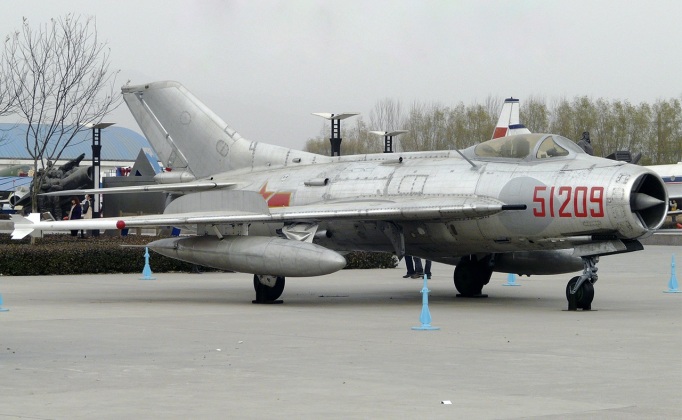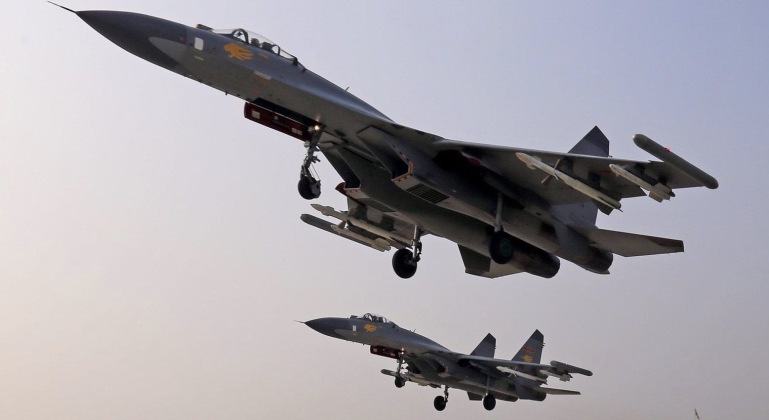In 1988 after thirty years of high tensions China and the Soviet Union made the first steps towards a normalisation of relations. With the Cold War coming to an end and the Soviet economy in decline under Mikhail Gorbachev’s Perestroika, Moscow sought to strengthen its geopolitical and economic positions and reduce its expenditures on military assets facing eastwards by reducing tensions with its largest neighbour and forming the beginnings of a constructive partnership. Better relations were quickly followed by discussions on the possibility of arms sale to modernise the Chinese People’s Liberation Army (PLA), which would have provided much needed revenues to the Soviet defence sector following the losses its Warsaw Pact client base as a well as a means of further cementing ties with Beijing. China had for the last decade been pursuing defence cooperation with the United States and Western European states to modernise its military, in particular its air force, with the U.S. supporting Chinese efforts to improve its troubled J-8 interceptor program and France providing air to air missiles for integration onto older Chinese J-7 fighters among other military items. These efforts had been pursued from the late 1970s as a means of strengthening China against the Soviet Union, although they came to an abrupt end at the end of the decade as Sino-U.S. and Sino-European relations deteriorated sharply, with the conclusion of the Cold War and Soviet decline removing the perceived need for the West to support Beijing against Moscow.

As discussions on sales of fighter aircraft to China were opened, the Soviet Union offered the MiG-29 Fulcrum fourth generation medium weight aircraft to meet the PLA’s needs. The MiG-29 was almost three decades ahead technologically of anything in Chinese service, and having entered service in 1982 it boasted a low speed flight performance without match and access to sensors and air to air missiles that were at least on par with the most capable foreign aircraft from its weight range. Although China had not purchased Soviet armaments for several decades, the country previously acquired hundreds of Soviet combat aircraft in the 1950s when Beijing and Moscow had been treaty allies. In the early years of the Cold War China had been the leading foreign client for Soviet combat aircraft, acquiring Tu-4, Il-28 and later Tu-16 bombers as well as MiG-9, MiG-15, MiG-17 and MiG-19 fighters and producing the Il-28, MiG-17 and MiG-19 under license domestically.
When the Chinese Communist Party came to power in 1949 the country had been ravaged by decades of war, suffered from widespread malnourishment, disease and opium addition, and had a negligible industrial base meaning even with effective management it would take several decades to bridge the industrial gap with leading powers. Thus when the Sino-Soviet split caused deterioration in relations in 1960, cutting off further Soviet arms shipments or technology transfers, China struggled to develop any new combat aircraft designs. It instead focused efforts on improving the capabilities of existing designs, namely the MiG-19 which it would continue to produce for over two decades as well as the Tu-16 and MiG-21 would it would eventually manage to manufacture domestically based on Soviet technical documents and a small number of airframes acquired. By the end of the Cold War, however, the Chinese People’s Liberation Army Air Force was technologically several decades behind the USSR with modernised MiG-19s forming the large majority of its fighter fleet. The MiG-19 and Chinese variants of the MiG-21 were at least two generations behind the MiG-29.

In September 1989, the Soviet “Red Star” published an exclusive interview with the Chief of Staff of the Soviet Army who told reporters that if China sought obtain the MiG-29 or other high performance Soviet jets: “the Soviet government believes that there is no political obstacle.” The MiG-29 was in production on a tremendous scale in the USSR at a rate of close to 100 airframes per year, and had already been widely exported to Warsaw Pact states, Iraq, Syria, North Korea and India. Considering the newfound geopolitical importance to Moscow of a rapprochement with China, permitting MiG-29 sales was far from unexpected. On April 23, 1990, Chinese Premier Li Peng paid an official visit to Moscow and proposed a restoration of cooperation in aviation. He further offered barter agreements of Chinese commodities including foodstuffs in exchange for aviation equipment. On May 31 Vice Chairman of the Chinese Central Military Commission Liu Huaqing led a military delegation to Moscow which reached an agreement on military-technical cooperation and opened the way to procedural negotiations for Soviet fighter acquisitions. The Chinese delegation at the time learned about existing Soviet fighter designs including models which had not previously been offered for export. It was arranged for the Chinese delegation to watch MiG-29 fighters and the Mi-28 and Mi-35 combat helicopters in flight. Also seen was the Su-27 Flanker heavyweight fighter, which at the time was widely considered the most capable in the world. The Flanker had entered service from 1985 with deployments concentrated on the USSR’s western front.

The Soviet Union had long withheld its most capable armaments from export, as seen not only in aviation but also in armour with its T-64 and T-80 tanks had never been sold abroad. This was done in part due to the long history of clients selling Soviet weapons on to the West for study, with Egypt and Indonesia being the most notable examples. As a result of this long standing policy, when the PLA expressed an interest in acquiring the Su-27 after learning more about is specifications the USSR refused. The MiG-29 and Su-27 had been developed in parallel as complementary fighters, with the former intended to be sold widely abroad, produced in larger numbers, and deployed closer to frontlines while the latter would perform long range missions and tackle the elite of an enemy air force. The enemy in mind at the time was U.S. Air Force F-15 Eagle that the Flanker had been designed specifically to neutralise. The Su-27 was considerably more expensive both to maintain and to acquire, but was more manoeuvrable at high speeds, deployed much more powerful sensors and longer ranged R-27ER/ET missiles, and used AL-31F engines that were considerably more efficient. Despite the MiG-29 far surpassing the performance of anything in the PLA fleet, and exceeding the capabilities of lighter F-16 and Mirage 2000 fighters it had previously reportedly considered acquiring from the U.S. and France, the existence of the Su-27 curbed Chinese interest in the lighter aircraft. One factor influencing this was that China’s J-10 lightweight fighter under development at the time was expected to fulfil a similar role to the MiG-29, where the Su-27 would provide unique capabilities that no other fighter had. Another factor was that the MiG-29’s specifications had largely been comprised by exports to Eastern European states, which following the fall of the Warsaw Pact placed their technological secrets at the disposal of the West.

Reports regarding how Soviet officials came to agree to export the Su-27 varied. One report claimed that during the talks they and Chinese officials who had studied in the Soviet Union recalled years of fraternal cooperation in the 1950s, influencing Soviet officials with sentiment to approve in principle Su-27 sales to China. Another emphasised that the USSR’s geopolitical situation and need for cooperation with China led it to concede on the issue. One Chinese source even claimed that Chinese interest in the Su-27 from the outset came about when officers from the two countries were drinking together and a Soviet officer, after several shots, accidentally revealed that the Su-27 was set to be made available for export which surprised the Chinese delegation and resulted in an end to interest in the MiG-29. On December 28, 1990, an agreement was signed for the export of 24 Su-27s to China. The first three were subsequently delivered before the USSR’s collapse in December 1991. This made China the first country permitted to acquire the fighters and the only one ever to receive them from the USSR. Seventy percent of the contract value was reportedly paid in barter transactions. China’s similar government model as a socialist party state is thought to have also influenced the Soviets to perceive it as a more reliable partner, where requests from other clients such as Iraq or Iran for such a sensitive aircraft were much more likely to have been refused. The MiG-29 had had a sufficient endurance for operations over Taiwan if sold to the PLA, and outmatched any Western fighters sold to Taipei, but the Su-27 ensured an ability to tackle F-15s of the U.S. and Japan and allowed Chinese air power to operate in a much higher league.

It can only be speculated whether, had it purchased the MiG-29, the PLA would have placed multiple followup orders and looked to license production as it later did with the Su-27. A significant possibility would have been that after the Soviet collapse, when Russia was offered all tactical weapons for export and lifted prior restrictions, the PLA would have cancelled further MiG-29 acquisitions in favour of the Su-27 possibly even returned or sold on its MiG-29s to avoid overly diversifying its fleet. Had the USSR offered the MiG-29 to China earlier in the 1980s, however, when it began exporting the fighter in 1985, there would have been a greater possibility of large scale acquisitions by China. The MiG-29 the following decade saw its performance significantly improved with a longer range and new engines, sensors and avionics which increased foreign interest in the design drastically. China went on to place two followup orders for Russian built Su-27s, and produced over 100 fighters under license domestically albeit with significant improvements made to the design as its own defence sector advanced rapidly. The Flanker design remains in production in China today, most notably as the J-16. Modern Chinese Flankers benefit from lighter stronger high composite airframes and more modern sensors and armaments than Flankers produced in Russia, reflecting the major turnaround in both the Chinese defence sector and the post-Soviet Russian economy in the 30 years following the Soviet collapse.
